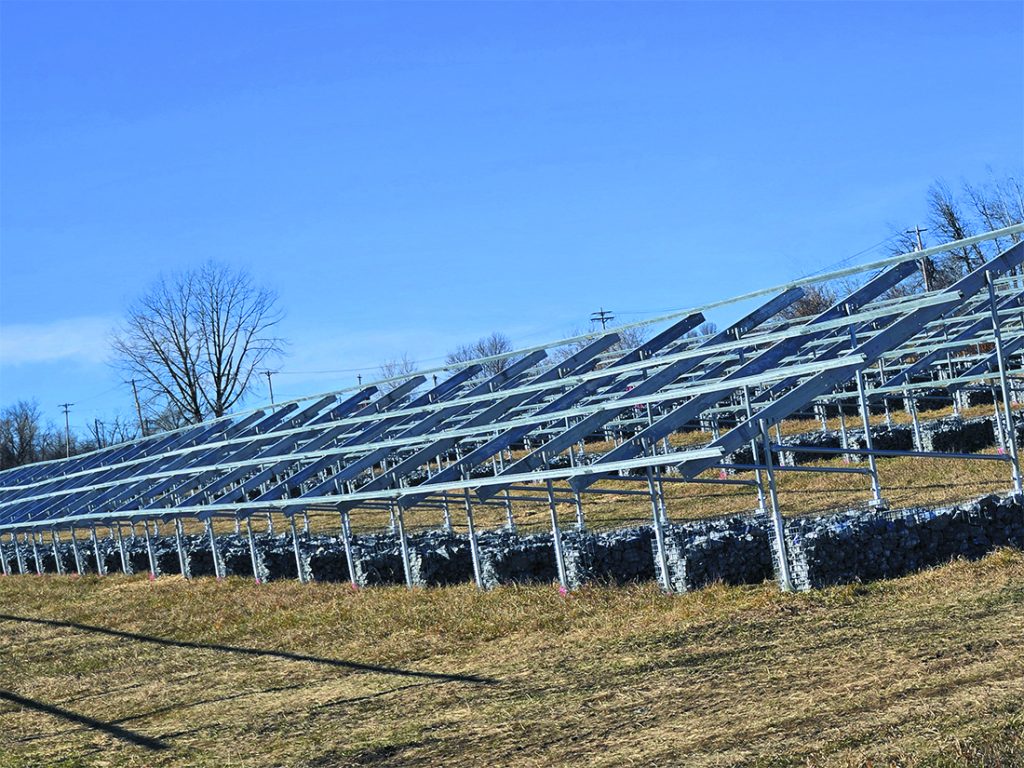
Courtesy of the Town of Queensbury
By Paul Post
An industrial brownfield site, vacant for 35 years, is being repurposed as a productive 6-megawatt community solar project.
The 44-acre former Ciba-Geigy property in South Queensbury borders the Hudson River, nestled between Perkins Recycling and the recently shuttered Glens Falls Cement Company plant.
“With its unobstructed southern exposure, a surface-mounted solar project is the best and only practical use for the site,” Queensbury Supervisor John Strough said. “It’s the least intrusive and will add value to the property.”
The site housed several industrial plants beginning in 1901, starting with wallpaper manufacturing and later producing inorganic pigments. Hercules Inc. took over operations in 1960, selling the property to Ciba-Geigy 19 years later. Ciba-Geigy ceased operations in 1989 and demolished the buildings soon after. A more-than-decade-long cleanup effort removed toxic chemicals and heavy metals, concluding in 2002. While the topsoil at the site is now safe, contaminants remain in bedrock fissures, making excavation for large commercial developments financially unfeasible.
“It would be very expensive to put anything else there,” Strough said. “We’re doing the green thing. It’s going to contribute to getting away from fossil fuel use.”
The project, expected to go online by mid-2025, was developed by New York City-based AC Power LLC, a company specializing in community solar projects on brownfields.
Community solar projects differ from large-scale solar arrays, which feed power directly to the grid.
“We sell subscriptions to residents, ideally in the local area,” said Annika Colston, AC Power founder and chief executive officer. “They can subscribe to that project and get a discount for their electricity.”
“We take sites that might not be attractive to long-term solar owner-operators because they take too much time, effort and risk to develop,” she said. “We do all that work up front so the project is attractive to a long-term owner.”
On June 25, AC Power celebrated the opening of a similar 6.9-megawatt project at the old Fort Edward landfill, which closed in 1991.
“This project supports New York State’s ambitious clean energy goals and showcases how innovative approaches can turn environmental challenges into sustainable opportunities,” Colston said.
New York State has targeted installing 3,000 megawatts of clean energy by 2030 and achieving zero-emissions electricity by 2040.
In Queensbury and Fort Edward, AC Power sold approved projects to Kendall Sustainable Infrastructure of Cambridge, Mass., which operates them. The Queensbury site is owned by BASF, a global German corporation that acquired Ciba-Geigy. BASF is leasing the property under a long-term agreement for solar use.
“The normal life expectancy is 20 years, but newer panels are so much more efficient there might not be a need to decommission then,” Strough said. “It might go beyond that, especially if we work out a way to store power that’s generated during the day to be used at night. We haven’t gotten there yet, but we can look at those possibilities down the road. They certainly have the property to do that.”
Colston said her firm specializes in project approval while leaving operations to other companies “because it’s quite a different skill set. It would require a much larger team.”
“As I grew the business, I decided to continue focusing on contract development, rather than diversify into construction management,” she said. “We’re most beneficial in the market by bringing more and more projects to these long-term owner-operators. We have more impact that way.”
Securing state and local approvals for the Queensbury project took more than two years, including financial incentives from the New York State Energy Research and Development Authority (NYSERDA).
Before founding AC Power, Colston developed small gas-to-energy landfill projects that utilized methane to generate electricity.
“I realized solar was the technology everybody was interested in and thought these landfill sites would make great candidates,” she said. “When I looked into it a couple of companies had done this in New York and Massachusetts, working with landfill owners to get them comfortable putting solar on these sites. We’re basically turning a community liability into a revenue-generating operation.”
AC Power has over a dozen solar projects either operational, under construction, or in development across multiple states. The firm is also exploring plans for a project at Queensbury’s landfill on Ridge Road.
“We’ve given them the go-ahead with the next step, which is determining if a National Grid substation has enough capacity, and would they have to invest money to upgrade it if needed,” Strough said.
The City of Glens Falls has also initiated steps for a community solar project at its landfill near Northway Exit 18. A request for proposals from developers was issued earlier this year.
“We’ll lease the land,” said Jeff Flagg, the city’s economic development director. “The city would hope to be an anchor tenant to get a discount on the power that’s generated there.”The project is expected to be completed in 2026, he said.
In 2017, NYSERDA and Onyx Renewable Partners completed a 2.6-megawatt solar project at Saratoga Springs’ former landfill. Featuring nearly 8,000 panels on 14.6 acres, the installation generates approximately 3,000 megawatt-hours annually and offsets around 1,605 metric tons of carbon dioxide emissions.
A recent Solar Energy Industries Association report highlighted a record-breaking 9.3 gigawatts of new solar module manufacturing capacity added in the U.S. during the third quarter, with domestically produced silicon cells re-entering the market for the first time since 2019.
While utilities and businesses are driving solar growth, community and commercial solar markets also saw gains, growing 12 percent and 44 percent year-over-year, respectively.
However, some proposed projects face community opposition over concerns about visual impact, property values, and rural character.
Tony DeFazio, founder of Glens Falls-based Sustainable PR, addressed these challenges at the New York Solar Energy Industry Association’s annual Solar Summit.
“New York’s transition to a clean energy will be won at the local level,” said DeFazio. “By proactively engaging communities and communicating the benefits of solar energy while addressing public concerns, only then will we accelerate the transition to a clean energy future.”
